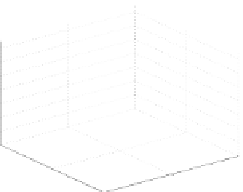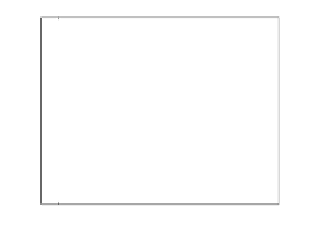Information Technology Reference
In-Depth Information
20.4
Simulation Results
For all presented simulations, the sampling time
T
e
is equal to 40 ms. This choice
allows considering real-time application with an usual camera (25 fps). The con-
trol task consists in positioning a perspective free-flying camera with respect to
a target composed of four points. These four points form a square of 20 cm in
length in Cartesian space. The reference image is obtained when the target pose
expressed in the camera frame (
R
C
) is equal to
P
T
/
C
=(0
0) (see Fig-
ure 20.3), where the first three components are the translation expressed in me-
ters and the last three components are the roll, pitch and yaw angles expressed
in radians. The coordinates of the four points in the reference image are:
s
∗
=
(
u
d
1
,
,
0
,
0
.
5
,
0
,
0
,
v
d
1
,
u
d
2
,
v
d
2
,
u
d
3
,
v
d
3
,
u
d
4
,
v
d
4
)=(
−
0
.
2
,
0
.
2
,
0
.
2
,
0
.
2
,
0
.
2
,−
0
.
2
,−
0
.
2
,−
0
.
2)
(see Figure 20.4).
Image plane
3D plane
0.3
−0.7
−0.6
−0.5
−0.4
−0.3
−0.2
−0.1
0.2
0.1
R
C
Z
C
Y
X
C
0
−0.1
X
T
R
T
Z
T
Y
T
−0.5
−0.2
0.5
0
−0.3
0
Y
0.5
−0.3
−0.2
−0.1
0
0.1
0.2
0.3
−0.5
X
u
Fig. 20.3
3D desired posture
Fig. 20.4
2D reference image
Different simulations illustrate the performance of the VPC strategy. Besides the
choice of the model used to predict the point positions, VPC requires to set three
parameters, the prediction horizon
N
p
, the control horizon
N
c
and the weighted ma-
trix
Q
(
j
):
•
the choice of the prediction horizon is crucial. The system behavior and the con-
vergence speed depend on the prediction horizon. The value of
N
p
is discussed
below;
•
the control horizon is kept constant and equal to 1 (
N
c
= 1). Only one control is
calculated over the prediction horizon; and
•
the weighted matrix
Q
(
j
) is either the identity matrix
Q
(
j
)=
I
8
×
8
∀
j
, constant
1) with
Q
(1)=
I
8
×
8
. In this last case, this matrix weights the error at each sampling
instant more and more over the prediction horizon and so, stresses the error at the
end of the horizon
N
p
which corresponds to the final objective. In stabilization
task, this time-varying matrix can be compared to the terminal constraint used
in the classical predictive control strategy. However it is less restrictive for the
optimization algorithm. In the sequel, the time-varying matrix is noted
Q
TV
.
The VPC simulation results are compared with the classical IBVS approaches based
on the exponential control law (20.1) where
L
s
can be chosen as:
over the prediction horizon, or a time-varying matrix
Q
(
j
)=2
Q
(
j
−



























Search WWH ::

Custom Search